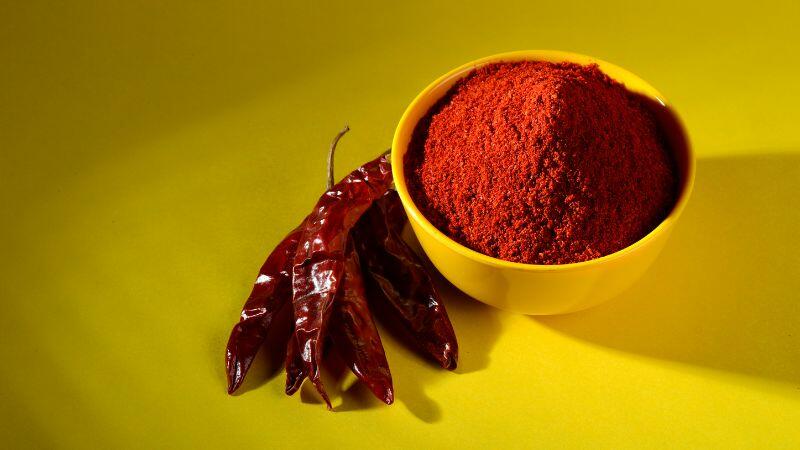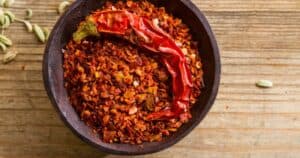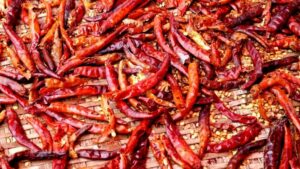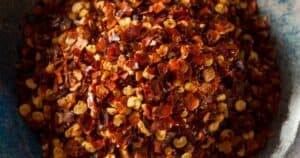If you’ve ever stood in the
The key difference: Kashmiri chili powder packs a mildly spicy, flavorful punch while regular chili powder brings some serious heat.
Kashmiri chili powder provides a rich red color and a mild kick of around 2,000 Scoville units. It’s made from grinding up dried Kashmiri chili peppers from northern India.
Regular chili powder can hit up to 30,000 Scoville units thanks to its blend of hot dried chilies like cayenne and chipotle. It’s pure firepower!
So in a Kashmiri chili powder vs chili powder throwdown, Kashmiri will add medium
Paprika vs Kashmiri Chili: A Hot Battle
First things first, neither Kashmiri chili powder nor regular chili powder are the same as paprika. I know, it’s crazy confusing!
Paprika comes from mild red bell peppers and simply provides color, not heat. It’s like the fairy godmother of spices – gently blessing dishes with its vibrant red hue without burning your mouth off.
Kashmiri chili powder comes from a blend of milder dried red chilies grown in (you guessed it) Kashmir, India. It adds a mildly spicy kick and deep, rich red color.
Regular chili powder packs the most heat, using a combo of hot chilies like cayenne, chipotle and more. We’re talking full-on dragon breath!
So if you’re looking for…
- A tame, colorful garnish: Paprika
- Medium zing + bold red: Kashmiri
- Pure firepower: Regular chili powder
Now let’s explore each of these chili champions in more detail so you can unlock their full flavor potential!
Paprika: The Crowning Glory of Color
Paprika is made from dried, ground bell peppers and other mild red peppers like pimientos. That’s why it adds vibrant color without much heat.
The paprika you find in most grocery stores hails from Hungary, South America or California. But you can also find smoked Spanish paprika, which gets a kick of flavor from oak-smoking the peppers during drying. Fancy!
3 Paprika Tips:
- Brighten up hummus, deviled eggs, potato salad – anything that needs a splash of red.
- Mix it into
spice rubs and marinades. - Add it at the end for color, not during cooking. Heat destroys the red pigments!
So for a harmless red glow, paprika is your go-to gal. Now let’s turn up the heat with Kashmiri chili powder.
Kashmiri Chili Powder: A Mild, Flavorful Kick
What happens when you grind up dried Kashmiri peppers grown in northern India? You get Kashmiri chili powder, also called Kashmiri lal mirch.
With a Scoville rating of about 2,000 units, it’s milder than traditional chili powder but still packs a bit of a punch. It provides a rich, deep red color like paprika. But it also gives a mild, almost sweet spicy flavor.
Kashmiri chili powder is sometimes called “poor man’s saffron” since it provides vibrant color without the crazy price tag. Use it to add both heat and visual appeal to dishes like:
- Tandoori chicken
- Curries
- Chili
- Soups
- Stir fries
So when you want more than just color but less than napalm-level heat, Kashmiri is your
Chili Powder: Pure Firepower
When you’re looking to really ignite some flavor, reach for good ol’ regular chili powder. It’s a blend of hot dried chilies like:
- Cayenne
- Ancho
- Chipotle
- Arbol
- Pasilla
The exact mix depends on the brand, but traditional chili powder packs some serious Scoville heat up to 30,000 units. That’s like 150+ times hotter than Kashmiri chili!
It doesn’t have quite as vivid of a red color as the other two. But what it lacks in looks, it more than makes up for in pure firepower.
Some ways to unleash its heat:
- Chili
- Tacos
- Spicy rubs
- Meat marinades
- Add heat to anything, but go slowly!
So for blazing hot
The Verdict? It Depends on Your Heat Tolerance!
At the end of the day, deciding between Kashmiri chili powder vs regular chili powder comes down to your desired level of heat:
- Paprika for pure color and no burn
- Kashmiri for mild kick and rich red hue
- Chili powder when you want the full-on fire factor
The most important thing is understanding how much spicy heat you can personally handle. Better to start mild and work your way up!
So put on your chef’s hat, experiment with these red-hot peppers, and find your perfect blend. Just stock up on milk and have 911 on speed dial…just in case!
Sources
- Wikipedia: Paprika
- MasterClass: What Is Paprika? How to Cook With 3 Different Types of Paprika – 2022
- Foods Guy: Does Paprika Go Bad? – How To Tell
- LinsFood: What is Kashmiri Chili?
- Curry Spy: Is Kashmiri Chilli Powder Hot? Essential Guide (2022 Update)
- Chili Pepper Madness: Hot Paprika: All About It





